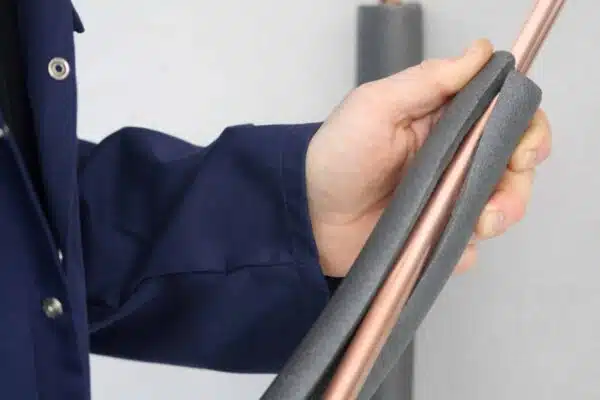Touchless faucets are transforming kitchens with their convenience, hygiene benefits, and water-saving features. Using motion sensors, they allow for hands-free control, making them perfect for busy households. They reduce water waste by shutting off automatically and help prevent the spread of germs by eliminating the need to touch handles with dirty hands. Popular features include adjustable water temperature, spot-resistant finishes, and smart home integration. With easy installation options and sleek designs, touchless faucets are a smart upgrade for any modern kitchen.

Do you ever get frustrated trying to turn on the faucet with messy hands? Or wish you could make your kitchen a little more high-tech? Touchless faucets are here to help! With a simple wave, these faucets can turn on and off, keeping things cleaner and saving water at the same time.
From Lancaster, PA to Lebanon and Reading, PA, homeowners are upgrading to this modern kitchen trend. Ready to learn how these hands-free gadgets work and why they’re worth considering? Let’s dive in!
Understanding Touchless Faucets
What Are Touchless Faucets?
Touchless faucets are basically a hands-free solution for your kitchen sink. Unlike traditional faucets with handles or knobs, these faucets use motion sensors to turn the water on and off.
That means no more struggling to turn on the tap when your hands are covered in flour or sticky from mixing ingredients! Just wave your hand near the sensor, and voila—instant water flow.
Not only are they convenient, but they’re also a fantastic way to keep your sink area cleaner since you’re not touching it with dirty hands.
How Do They Work?
Touchless faucets use a tiny infrared sensor that detects when your hand (or anything else) is nearby. When it senses movement, it sends a signal to a solenoid valve, which then opens up to let water flow.
Move your hand away, and the sensor tells the valve to close. Some models have an adjustable sensitivity, so you can tweak how easily it responds.
And don’t worry—many of these faucets have a manual option, so you can still turn them on the old-fashioned way if you need to.
Benefits of Touchless Faucets
Improved Hygiene
One of the biggest reasons people love touchless faucets is for the hygiene factor. Think about it: when you’re handling raw meat or cutting vegetables, you don’t want to spread bacteria to your faucet handles.
With a touchless faucet, you won’t have to. Since you’re not physically touching the faucet, you can avoid cross-contamination and keep your kitchen a whole lot cleaner. This makes them perfect for busy kitchens where cleanliness is a top priority.
Water Conservation
The faucet automatically shuts off when you’re not using it, there’s less wasted water. No more leaving the tap running while scrubbing dishes or washing your hands! This is great for both the environment and your water bill.
Even a small reduction in wasted water can add up over time, making touchless faucets a smart choice for eco-conscious homeowners.
Convenience in the Kitchen
Let’s face it—having a touchless faucet in the kitchen just makes life easier. You can fill up pots, wash sticky hands, or rinse vegetables without having to touch a handle. It’s especially helpful when you’re multitasking and have your hands full.
Whether you’re a cooking enthusiast or just want to make everyday tasks simpler, a touchless faucet adds a level of convenience that’s hard to beat.
Popular Features of Touchless Faucets
Sensor Technology
Not all touchless faucets are created equal, and the sensor technology is what sets many apart. Most touchless faucets use infrared sensors, which detect movement within a specific range, but there are also capacitive sensors that respond to the presence of any object, like a pot or pan.
Some higher-end models even have multi-sensor technology, allowing you to control different functions by waving your hand in various spots.
This ensures better accuracy and responsiveness, which means fewer accidental water bursts and a smoother experience overall.
Adjustable Water Temperature and Flow
Many touchless faucets now come with easy-to-use temperature control settings. Some even let you pre-set your preferred temperature so that every time you turn on the faucet, the water is just the way you like it.
You can also adjust the water flow, whether you need a gentle stream for rinsing or a powerful blast for filling up a pot. This flexibility makes cooking and cleaning up much faster and hassle-free.
Easy Maintenance
Touchless faucets are surprisingly low maintenance. Because you’re not constantly touching the faucet, there are fewer smudges and fingerprints to wipe off.
Plus, many models come with spot-resistant finishes to keep them looking shiny and new with minimal cleaning.
If you ever need to clean the sensors, it’s as simple as wiping them with a soft cloth. Less time spent scrubbing means more time to enjoy your kitchen!
Touchless Faucets vs. Traditional Faucets
When comparing hands-free models to traditional faucets, the differences become clear in terms of functionality, hygiene, and overall convenience. Here’s a closer look at how each type stacks up and which one might be the right fit for your kitchen:
Traditional Fixtures:
- Operation: Traditional faucets require manual turning of handles or knobs to adjust water flow and temperature. This can be cumbersome, especially if your hands are dirty or full. Imagine trying to turn on the tap while holding a pot, or with greasy hands—it’s not always easy.
- Cleanliness: Touching handles repeatedly can spread germs and leave behind smudges and dirt. This means you’ll need to clean your faucet more often to maintain its appearance and hygiene. Plus, bacteria and contaminants can easily spread when you’re handling raw ingredients.
- Water Usage: Traditional models are prone to water wastage, especially if left running unintentionally. Forgetting to turn off the tap while rinsing dishes or washing hands can quickly add up, leading to higher water bills and unnecessary environmental impact.
- Usability: Manual operation can become a hassle during multitasking in the kitchen, such as cooking or cleaning. Trying to turn on the faucet when your hands are occupied can be frustrating and inefficient, slowing you down during busy meal prep.
Touchless Faucets
- Activation: Hands-free faucets activate with a simple wave or by placing your hand in front of the sensor. This means you can easily turn the water on and off without touching anything, which is perfect when your hands are messy from cooking or handling raw food.
- Hygiene: Because there’s no need to touch the faucet, hands-free models significantly reduce the spread of germs and bacteria. This is especially beneficial when working with raw meats or other ingredients that can contaminate surfaces. Less touching also means fewer smudges, keeping your kitchen looking cleaner for longer.
- Efficiency: These models are designed to shut off automatically when not in use, ensuring that no water is wasted. This helps conserve water and can lower your utility bills over time. Some models even come with additional settings, like eco-mode, which uses less water for everyday tasks.
- Practicality: Hands-free faucets make multitasking a breeze, whether you’re washing dishes, rinsing vegetables, or filling a pot with water. They’re also a great option for families with kids, making it easier for everyone to use the faucet without the risk of leaving it running.
From a design perspective, no-touch faucets bring a modern, sleek appearance that blends well into contemporary kitchens. They’re available in a variety of finishes, such as stainless steel, chrome, and matte black, making it easy to find one that matches your kitchen’s style.
Choosing the Right Model
Selecting the perfect hands-free fixture depends on your kitchen needs and preferences. Start by considering sensor sensitivity and placement.
Some models have sensors at the base, while others are located on the spout. Choosing the right placement ensures smooth operation without accidental activations.
Next, look at power options. No-touch faucets can be powered by batteries or connected to your home’s electrical system.
Battery-powered models are easier to install but may require frequent battery changes. Hardwired options don’t need battery replacements but might require professional installation.
Also, think about style and finish. Choose from various finishes like stainless steel, chrome, or matte black, to match your kitchen’s look.
Don’t forget about additional features such as adjustable water temperature, manual override, and spot-resistant finishes for easy cleaning. By focusing on these factors, you can find a faucet that suits your kitchen and lifestyle perfectly.
Installation and Setup Tips
Setting up your new hands-free faucet can seem daunting, but it doesn’t have to be. The first step is deciding whether to tackle a DIY installation or hire a professional.
If you’re comfortable working with basic plumbing, most faucets come with step-by-step instructions and require only a few tools, like a wrench and plumber’s tape.
However, if electrical wiring is involved or your current sink setup is complicated, hiring a professional ensures everything works correctly.
DIY Installation vs. Hiring a Professional
For simple setups, installing the faucet yourself can save money and time. The process usually involves removing the old fixture, connecting the new faucet to your water supply lines, and testing the sensor to ensure it’s functioning properly.
If you choose to hire a pro, you’ll benefit from their experience, which can prevent costly mistakes and provide peace of mind, especially if the model has advanced features that require fine-tuning.
Step-by-Step Installation Guide
Before you begin, remember that it’s always best to hire a professional to ensure your faucet is installed safely and correctly. However, if you choose to proceed with a DIY approach, follow these steps for a smoother experience:
- Turn Off the Water Supply: Shut off the water valves under your sink and drain any remaining water by briefly turning on the old faucet.
- Remove the Old Faucet: Use a wrench to loosen the nuts securing the old fixture. Disconnect the supply lines, lift out the faucet, and clean the area thoroughly.
- Position the New Faucet: Insert the new faucet into the mounting hole, ensuring it’s centered. If your model has a deck plate, position it before placing the faucet.
- Connect Water Lines: Attach the hot and cold supply lines to the valves. Secure the connections tightly and use the plumber’s tape if needed. Ensure lines aren’t crossed to avoid mixing hot and cold water.
- Install Sensor and Power Source: For touchless models, connect the motion sensor as directed. This may involve setting up a battery pack or connecting to an electrical outlet.
- Test the Faucet: Turn on the water supply and wave your hand near the sensor to check for smooth operation, proper water flow, and leaks.
If you experience complications, always remember that reaching out to a professional is the safest way to handle any installation issues.
Troubleshooting Common Issues
If your new faucet isn’t working as expected, common problems include sensor misalignment, low battery power, or incorrect water line connections.
Adjusting the sensor’s range or replacing batteries often solves most issues. For more complex troubleshooting, refer to the manual or consult a professional plumber.
Future Trends in Kitchen Technology
The kitchen is quickly becoming one of the most tech-savvy areas of the home, with innovations that go beyond just touchless faucets.
As technology advances, we’re seeing more gadgets and features that are making kitchens smarter, more sustainable, and even more connected. Let’s take a look at a few exciting trends that are shaping the future of kitchen spaces.
Smart Home Integration
Smart home technology is everywhere these days, and it’s making its way into the kitchen, too. Many newer faucets are being integrated into smart home systems like Amazon Alexa or Google Assistant, allowing you to turn on the faucet with a voice command or adjust the water temperature remotely.
Some models even come with smartphone apps that let you monitor water usage, set timers, or control the faucet from anywhere in the house.
This level of control and convenience is turning the kitchen into a truly smart space, perfect for busy families who want everything at their fingertips.
Innovations on the Horizon
The future is all about automation and personalization. Manufacturers are constantly working on new features like temperature memory settings that recall your preferred water temperature and gesture controls that allow you to customize water flow and spray patterns with simple hand movements.
Touchless technology is also being enhanced to be more precise, using multiple sensors to prevent false activations and improve reliability.
These innovations are designed to make cooking, cleaning, and everyday kitchen tasks even more efficient and enjoyable.
Sustainability Efforts
As environmental concerns become a bigger focus, many manufacturers are designing products that contribute to sustainability. Upcoming models may include features like integrated water filtration systems, reduced water flow rates, and even recycled materials used in faucet construction.
These efforts not only help homeowners reduce their water consumption but also support a greener planet. Future kitchen faucets are expected to be more energy-efficient and eco-friendly, making them a great choice for those who want to lower their environmental footprint without sacrificing style or functionality.
Upgrade Your Kitchen with Modern Touchless Faucets Today!
Ready to bring convenience and style to your kitchen in Lancaster, PA, Lebanon, PA, or Reading, PA? At Benjamin Franklin Plumbing of Lancaster, we specialize in installing high-quality touchless faucets that blend functionality with elegance.
Our professional team is here to help you choose the perfect model to fit your needs and budget. Contact us today to schedule your installation and enjoy a smarter, more efficient kitchen!

FAQs
Are touchless faucets worth the investment?
Yes, touchless faucets are a great investment for many homeowners. While the initial cost can be higher than traditional models, they offer a range of benefits that justify the price. These include improved hygiene, water savings, and the convenience of hands-free operation.
Can touchless faucets work during a power outage?
Most touchless faucets can still work during a power outage, depending on the power source. If your faucet is battery-operated, it will continue to function normally. However, models that rely on being plugged into an outlet may not work until power is restored.
How do I clean and maintain my touchless faucet?
Cleaning and maintaining your faucet is simple. For regular cleaning, use a mild soap and a soft cloth to wipe down the surface. Avoid harsh chemicals or abrasive pads, as they can damage the finish. To keep the sensors working correctly, wipe them gently with a damp cloth to remove any dirt or residue.
Are touchless faucets compatible with all sinks?
Most touchless faucets are compatible with standard sinks, but it’s essential to check the specifications of the model you’re considering. Pay attention to the number of holes in your sink and the required spacing for installation. Some models include a deck plate that covers additional holes, making them versatile for various sink setups.
Do touchless faucets help reduce water usage?
Absolutely! Because the faucet only turns on when needed, it significantly reduces water waste. This is particularly beneficial for households looking to lower their water bills or reduce their environmental impact.





















